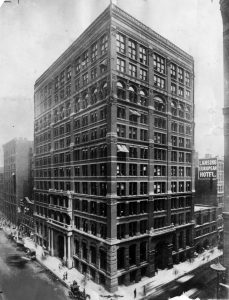Immediate Recovery Efforts

Corner of State and Madison After the Fire
Recovery efforts began almost immediately in the days following the fire. Although the fire left in its wake, destruction that spanned nearly four miles long and one mile wide, including most of Chicago’s business district (History.com, “Chicago Fire of 1871”, Aug. 2018), the city began rebuilding in the blink of an eye. At the time of the fire, Chicago’s positioning in the center of national water and rail transportation along with its flourishing economy, enabled the city to “rise again, like a Phoenix from the ashes” (Chicago Architecture Center).
Sense of Unity
As is the case with many disasters, there was a sense of unity amongst the people most impacted, as well as the nation as a whole. Chicagoans were panicked at first, but within a couple of days, there was word of relief efforts being conducted as other major cities across the country began sending money and fire-fighting equipment to assist in the recovery effort. In the end, Chicago had received nearly four million dollars in aid from the outside world (Pauly 1984, p. 671).
“Great Rebuilding” – a new urban center
The efforts to rebuild the city focused primarily on constructing a new, modern urban center, a process that some historians call the “Great Rebuilding” (Schons 2011). Due to the fact that most infrastructure, including many of the transportation systems, remained intact throughout the fire, the reconstruction and recovery efforts were performed with relative ease. Additionally, the city saw rapid economic development as well as population growth in the years after the fire, likely because the agricultural and trade industries throughout Chicago kept the city’s finances as stable as possible and employed thousands of people in the aftermath of the tragedy (Schons 2011). Industries that were not impacted by the fire fueled the city’s economy and expansive growth and development.
Did the fire contribute to the city’s growth?

The rise of skyscrapers in the decades following the fire
Historians and architects debate whether or not Chicago would have developed the same way and become the major city that it is today without the fire. In fact, many historians believe that Chicago would not be the large and influential metropolis that it is today had the Great Fire of 1871 not occurred. They argue that it would be a much smaller city, definitely not one of the great cities in the nation (Chicago Architecture Center).
Architects often argue that the fire essentially “cleared out” the city, enabling them to lay the foundation for a modern, urban center, which was the goal of the “Great Rebuilding” (History.com, “Chicago Fire of 1871”, Aug. 2018). This “clearing” of land allowed for the rise of skyscrapers, the introduction of bigger businesses, as well as innovative buildings with a new style of architecture that was developed and became popular in the aftermath of the fire (Schons 2011). In the mind of architects, these big banks and businesses would soon come to dominate Chicago’s new, modern business district. However, what actually happened was that business owners didn’t have the time and money to invest in this new type of fire-proof architecture that architects imagined would dominate the new urban center, thus, they simply rebuilt what they already knew and had the funds for (Chicago Architecture Center). In fact, it took a couple of decades for this new style of architecture, the rise of skyscrapers, and architect’s vision of a new, modern urban center, to come to fruition.
Population Growth
Although these visions were not necessarily fully accomplished until several years after the fire, the city saw extraordinary population growth from 1871 to 1890 in particular (see below).
1871 (Great Chicago Fire): approx. 300,000
1880: approx. 500,000
1890: approx. 1 million
(“Chicago Fire of 1871”, Aug. 2018)
Architecture – Terra cotta
Furthermore, the city was trying out new construction techniques, one of which was using terra cotta clay. Terra cotta instantly became popular as it was easy to use and fire-proof, one of the most prominent requirements of a construction material at the time. In fact, by 1880, just nine years after the fire, Chicago had become one of the most fireproof cities in the nation as a result of widespread use of terra cotta clay (Schons 2011).
